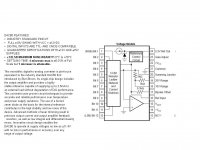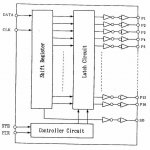Re: Re: Re: unanswered questions
Yep, you are right Kuei. I got it mixed up with Levinson
30.5 / 30.6. 30.5 had UA module, 30.6 uses PCM1704/OPA627.
All these discrete dacs (lavry + UA) use a sample and hold
OP clocked by the XO. Probably this is because they could
not build a sign magnitude architecture and infringe Burr Browns
patent. As such they need the S+H output to have clean state
changes.
Terry
Kuei Yang Wang said:Konnichiwa,
No, it uses (used) UA, actually, custom made with passive IV off board.
Sayonara
Yep, you are right Kuei. I got it mixed up with Levinson
30.5 / 30.6. 30.5 had UA module, 30.6 uses PCM1704/OPA627.
All these discrete dacs (lavry + UA) use a sample and hold
OP clocked by the XO. Probably this is because they could
not build a sign magnitude architecture and infringe Burr Browns
patent. As such they need the S+H output to have clean state
changes.
Terry
Using Signed magnitude for DIY
Can the signed magnitude approach be used for DIY designs ?
What about sharing a schematic for a DIY dac using signed magnitude ?
If signed magnitude can't be used, an approach were the MSB bits are split up into smaller "steps" can be used. Or is something like this patented ?
Can the signed magnitude approach be used for DIY designs ?
What about sharing a schematic for a DIY dac using signed magnitude ?
If signed magnitude can't be used, an approach were the MSB bits are split up into smaller "steps" can be used. Or is something like this patented ?
Comments on how to make prescision low noise Current source
Hopefully I'll soon begin making the DIY DAC.
The current source is one of the essential parts in the DAC, and will be one of the first parts I'll test.
I've made this suggestion to a current source :
http://www.diyaudio.com/forums/attachment.php?s=&postid=508263&stamp=1099947368
Any better suggestions, or improvements ?
Hopefully I'll soon begin making the DIY DAC.
The current source is one of the essential parts in the DAC, and will be one of the first parts I'll test.
I've made this suggestion to a current source :
http://www.diyaudio.com/forums/attachment.php?s=&postid=508263&stamp=1099947368
Any better suggestions, or improvements ?
New idea's minimizing jitter
To minimize jitter, and get fast settling time the DAC should consist of two DAC's whith the wanted resolution(16 bit).
A ultra fast switch should switch the active DAC for each sample period.
The settling time for each DAC will then not be critical.
The switch which I think is the most critical part in the DAC can now be highly optimized because only one extremly fast switch instead of 16 is needed.
The disadvantage is that the two DAC's must give same absolute current output.
This is very simular to S/H in a conventional DAC.
What do you think ? is there other ways to make fast(and relative cheap) switch in a Weighted Current source DAC ?
To minimize jitter, and get fast settling time the DAC should consist of two DAC's whith the wanted resolution(16 bit).
A ultra fast switch should switch the active DAC for each sample period.
The settling time for each DAC will then not be critical.
The switch which I think is the most critical part in the DAC can now be highly optimized because only one extremly fast switch instead of 16 is needed.
The disadvantage is that the two DAC's must give same absolute current output.
This is very simular to S/H in a conventional DAC.
What do you think ? is there other ways to make fast(and relative cheap) switch in a Weighted Current source DAC ?
Lgrau said:I was wondering if anyone have made a discrete konverter chip themselves.
Should be a farly simple task. The circuit will give a lot of opertunities for optimizing the perfomance.
Sorry for my poor english but my english spelling check isn't installed yet.
/Lennart
I found a Burr Brown DAC80 chip yesterday. It has a 12 bit D/A, all separately accessible on bit-level. Adding just 4 bits with current sources (FETS) would really make a rather discrete 16 bit DAC. Excellent settling time.
Any ideas someone?
regards albert
http://www.analog.com/en/prod/0,,774_1082_ADDAC80,00.html
Attachments
the V (voltage out) type.Bernhard said:Is it -V or -I model ? -V is a problem...
What's the problem (the summing I expect).
albert
Bernhard said:Yes, the summing.
Now an odd suggestion:
as pin 20 is plain out (in the logical diagram, I admit, not the physical) thus would provide Real Current for external I/V IF and only IF the internal OpAmp would not provide the current dump (in its I/V work).
Now, to do that, this would imply shorting it with a 1 Hz filter. If you understand what I mean.
albert
Perhaps look for something else.
My experience is that instrumentation DACs are not as good as audio DACs. So far.
But they look pretty 😀
My experience is that instrumentation DACs are not as good as audio DACs. So far.
But they look pretty 😀
Hi, I am glad to have found this thread while searching for information on building a completely discrete r2r diy dac!
So whats the progress so far ? I hope encouraging!
So whats the progress so far ? I hope encouraging!
percy said:Hi, I am glad to have found this thread while searching for information on building a completely discrete r2r diy dac!
So whats the progress so far ? I hope encouraging!
Pondering.
yes, good links from ' rfbrw '!
Lets look again at the 1543. Good,dynamic. But like a donut:
'Keep your eye on the (w)hole and not on the donut' - it's if I quote correctly, an american proverb.
In our case: Focus on the whole and not on the hole in the middle.
So, having said that, what would the reason be for a hole in the middle? Some L-R interference on the powerline? Maybe due to the multiplexing of the same output device on the two output channels?
So a discrete dac like the burr brown would allow a real solid line to be set. 12 bits, and either go to 14 bits with 4x oversampling (could sound as good as NOS 16 bits in my opinion).
2 bits, on the bottom (the LSB is now 400 so much micro amperes. So it can easily be extended there.
And yes, if there is some nice converter to 16 channels, then just pumping these devices at 44khz to 88 khz or even 186khz would not hurt them a bit. --> Discrete 16-bit DAC (CS8412 input receiver, mode 5 output format) for start with... does anyone have a board that outputs this and can be fed directly inot the Burr-Brown (the 12 singular bit entries)?
2) Stil thinking how this -vVersion of the DAC-80 can be converted into -iMode! Actually just floating the output on 10k or even 100k would just swing it to either rail. This should give the current out in all freedom.

--> if that were true we also would have a solution to get the 1-bit chips free of the output summing opamp that is in the chip!!
http://www.spectralaudio.com/sdr-2000.htm
Has anyone heard about this discrete DAC from this ultra highend manufacturer? Sounds interesting but has anyone ever heard this thing?
Has anyone heard about this discrete DAC from this ultra highend manufacturer? Sounds interesting but has anyone ever heard this thing?
MGH said:http://www.spectralaudio.com/sdr-2000.htm
Has anyone heard about this discrete DAC from this ultra highend manufacturer? Sounds interesting but has anyone ever heard this thing?
AFAIK Ultra Analog modules
cheers
Terry
Any news ?
I have collected 16 DAC chips with parallel data input, Iout and access to the Vref.
Connecting all DACs - each using another bit only - to a single Vref using tight adjustment pots Sfernice ceramic multiturn could work.
Accuphase had a discrete DAC in their first transport / DAC combos: 16 bit 2x os ( I have borrowed from a friend to make measurements ) and 20bit 8x os.
They used ICM8019 integrated current source / switch 4 bit per chip.
Plus pots for the 4 MSBs.
The whole thing is very temperature sensitive...
I have collected 16 DAC chips with parallel data input, Iout and access to the Vref.
Connecting all DACs - each using another bit only - to a single Vref using tight adjustment pots Sfernice ceramic multiturn could work.
Accuphase had a discrete DAC in their first transport / DAC combos: 16 bit 2x os ( I have borrowed from a friend to make measurements ) and 20bit 8x os.
They used ICM8019 integrated current source / switch 4 bit per chip.
Plus pots for the 4 MSBs.
The whole thing is very temperature sensitive...
I built a prototype discrete DAC using MOSFET switches. Here is the description and the circuit diagram, along with some photos:
http://www.freeweb.hu/tube/DDAC.html
Sorry, it is in Hungarian...
http://www.freeweb.hu/tube/DDAC.html
Sorry, it is in Hungarian...
oshifis
How about using a chip that inputs serial and outputs parallel each bit separately. I found this chip: NJU3716M, 16 bit output producer. (an 18bit version also exists.)
This would provide an output directly, allow adding an output stage of any configuration you like.
The chips works up to 5 Mhz input rate, fast enough I think.
regards
albert
How about using a chip that inputs serial and outputs parallel each bit separately. I found this chip: NJU3716M, 16 bit output producer. (an 18bit version also exists.)
This would provide an output directly, allow adding an output stage of any configuration you like.
The chips works up to 5 Mhz input rate, fast enough I think.
regards
albert
Attachments
- Status
- Not open for further replies.
- Home
- Source & Line
- Digital Line Level
- DIY discrete dac chip.

